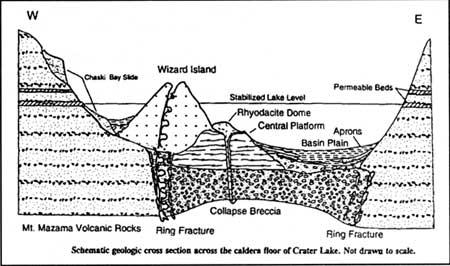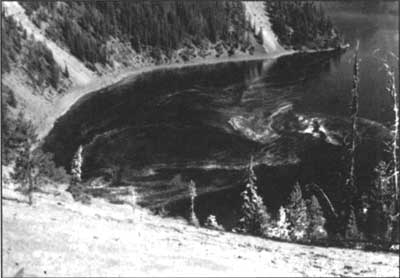|
Volume XXX - 1999
Answers from the Deep
By Tom McDonough
Crater Lake is certainly a sight to behold. It is especially
spectacular for those who see it for the first time. Pictures cannot
really capture the lake's magnitude and its image seems ageless. The
base of the great volcano, which stood here once, properly frames the
cobalt blue of the lake. These rugged cliffs are mostly bare,
undoubtedly stripped of vegetation by continual rockfall. What of Wizard
Island? It somehow seems fitting to have a winged dinosaur fly in
circles around the cone. These creatures were long gone, however, when
the fires of Mount Mazama first began to burn less than a half million
years ago.
The apparent serenity of this lake is somewhat misleading. We must
face the reality that this image is fleeting, or in the geologic time
scale, ephemeral. Why should we expect Crater Lake to always be the same
when it has changed so much in the past? A deep lake with a small
volcanic island near one shore are its dominant features, though how
each formed has been somewhat of a mystery until recently. By analyzing
lake sediments obtained from the bottom, scientists can now tell us much
more about what has happened here since Mount Mazama last erupted 7,700
years ago.
This crater (or caldera) holding Crater Lake today was created by a
great eruption. That event ended with the collapse of the mountain
summit, and was much more catastrophic than the Mount St. Helens
incident in 1980. It may have been the biggest occurrence of its kind in
North America during the last several million years. During the
eruption, Mount Mazama released great quantities of ash and pumice. At
least 12 cubic miles of mountain top disappeared as it slumped back into
a drained magma chamber located beneath the volcano, now below the lake
bottom.
During the summers of 1988 and 1989, a piloted submersible was used
for the first time to explore the bottom of Crater Lake. Videos
identified active thermal springs on the caldera floor, indicating the
presence of heat below. Hot water rises up, in various locations,
through layers of lake sediment that have accumulated since Crater Lake
formed. Five sediment core samples were taken from selected sites on the
lake bottom during these dives. The sample taken east of Wizard Island,
on a series of lava domes called the Central Platform, lacks the rock
debris covering other sites and therefore better displays the materials
that have settled here from above. These include volcanic ash, soot from
forest fires, pollen grains, and diatoms layered in a fine mud about
five feet in depth. By looking closely at this core sample, geologists
can now work out what kind of events have transpired in and around the
caldera over the last several thousand years.

Diagram courtesy of U.S. Geological Survey.
At the core's base is mud, whose age indicates that it was deposited
very soon after the caldera was formed. Dr. Charles Bacon, a
volcanologist with the U.S. Geological Survey, speculates that only 300
years may have been needed to fill the lake basin to its present level.
By the time water flowed over the top of the Central Platform, something
that took a minimum of 150 years, the lake was already 1,000 feet deep
over in the eastern basin, Obviously, winter snow and ground water
easily found a repository in the large cavity left by the devastating
eruption of Mount Mazama.
Crater Lake was approaching its present depth when Wizard Island
appeared. We know this by examining its lava rocks 250 feet below the
present water level. This was the water line for the lake when the event
that produced Wizard Island occurred. The lava above this point looks
different than the same lava below it. The lava, which was forced to
cool in water, is left with a somewhat glassy appearance. The same rock,
which cooled above the level attained by water at that time, has an
oxidized surface and appears rusty red or brown. Since Crater Lake was
lower when Wizard Island formed, it was not yet an island, At least
several more decades were needed to allow the lake to enter Skell
Channel and inundate the lava flows that connected Wizard Island to the
caldera walls. Some of this lava made its way into the sediment over the
Central Platform. Since the sediment appears near the core sample's
base, it provides more evidence that Wizard Island appeared not long
after Mount Mazama collapsed.
The core sample extracted from the Central Platform shows that a
second volcanic event occurred. Located approximately at the midpoint in
the lake sediment is an ash deposit from activity related to creation of
the Rhyodacite Dome, a feature situated immediately east of Wizard
Island. Organic material within the ash layer indicates this eruption
occurred 5,100 years ago. This is possibly the most recent volcanism
related to Crater Lake. The absence of other activity since that time,
however, does not indicate the volcano's extinction.
Sediments on the lake bottom also contain pollen grains and diatoms.
Scientists can broadly ascertain vegetation history patterns and related
climate changes over the past few thousand years by studying them.
Pollen, carried by the wind, entered the caldera soon after it formed,
Even though the local pine and fir forests were decimated during the
climactic eruption, other conifers located further away persisted. As
water began to accumulate, pollen grains became a permanent part of the
lake sediment. The appearance of pollen from Abies (true fir) in
the core samples may be evidence for the recovery and reestablishment of
the local forest, Fir pollen is relatively heavy and does not travel far
from its source, It first appeared in lake sediments after a few hundred
years, but just as this species became well-established, it and certain
pine species began to decline. The pollen record shows that
incense-cedar, western juniper, and Douglas-fir (all of which prefer a
warmer and drier climate than the true fir) replaced them. These
conditions prevailed for a thousand years and affected the entire
Pacific Northwest. Pronounced change took place at lower elevations,
where Lower Klamath Lake and Tule Lake all but disappeared. What effect
the dry climate had on Crater Lake is not known. Currently, 67 inches of
annual precipitation are needed to maintain the lake level. Evaporation
and seepage would lower the lake level without a steady input from rain
and snow. Perhaps Wizard Island was, once again, connected to the
caldera walls during this period.

Pollen on lake in Steel Bay. NPS photo
Diatoms in the core samples provide researchers with information
about lake water at various times. These microscopic silica skeletons
are the remains of a type of algae and there are many different forms.
As with other plants, the presence of one species or several related
species can tell scientists something about the local environment,
Eighteen different species of diatoms were examined from the core
samples. Nine of them drift in the water column, whereas the other nine
prefer the bottom of the lake.
The first species to establish itself was Stephanodiscus, a
type of diatom that prefers fresh water, Others requiring a more
mineral-rich and basic supply of water slowly replaced them and in
abundance. This change may indicate that the lake water was slowly
enriched with chemicals from hydrothermal vents, not unlike those seen
with the submersible. Diatom concentration reached a maximum about
4,000 years ago following the dome building event that occurred east of
Wizard Island, Since then, concentrations have slowly decreased for
most species, though why is not well understood, Lake transparency
has improved with this decrease since diatoms are effective scattering
agents. In large concentrations they prevent light rays from
travelling very far. With this in mind, Dr. Hans Nelson, a limnologist
with the U.S. Geological Survey, is convinced that the lake's
exceptional clarity is a relatively recent phenomenon.
The peaceful setting of Crater Lake at the present time stands in
sharp contrast to the violence which produced this picture. In the
absence of continued volcanic activity, the water has slowly been
purified by an abundance of rain and snow. We are often reminded by
geologists that this volcano is only dormant. If the past is any
indication of the future, the tranquility we enjoy today is only
temporary. A new mountain may stand here someday and it is possible that
our descendants may be limited to only imagining the lake we now
see.
References
C.H. Nelson, et al., "The volcanic, sedimentologic, and
paleolimnologic history of the Crater Lake caldera floor, Oregon:
Evidence for small caldera evolution," Geological Society of
America Bulletin 106 (May 1994), pp. 684-704.
C.R. Bacon, "Geological Observations and Sampling," pp. C1-C3,
in Robert W. Collier, et al (eds.), Studies of Hydrothermal
Processes in Crater Lake, OR, OSU College of Oceanography Report
#90-7, Corvallis, May 31,1991.
Tom McDonough teaches science at Chemeketa Community College
in Salem, Oregon and began working seasonally at Crater Lake National
Park thirty years ago.
|

